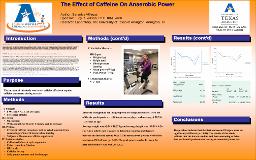
ATTENTION: The works hosted here are being migrated to a new repository that will consolidate resources, improve discoverability, and better show UTA's research impact on the global community. We will update authors as the migration progresses. Please see MavMatrix for more information.
Show simple item record
| dc.contributor.author | Villegas, Berenice | |
| dc.date.accessioned | 2019-04-09T22:46:54Z | |
| dc.date.available | 2019-04-09T22:46:54Z | |
| dc.date.issued | 2018-12 | |
| dc.identifier.uri | http://hdl.handle.net/10106/27928 | |
| dc.description | KINE 4400 | |
| dc.description.abstract | **Please note that the full text is embargoed** ABSTRACT: INTRODUCTION: Caffeine is a stimulant used by athletes to help enhance performance. Caffeine has shown to benefit endurance performance in high intensity or power sports. It has been recommended to consume about 200-400 mg of caffeine 20-30 minutes before a workout. Caffeine increases alertness and decreases fatigue due to blockage of adenosine in the brain. During exercise, caffeine consumption causes the body to mobilize fat stores before using glycogen supply. Doing so helps prolong exercise by sparing stored glycogen for later. Caffeine is a drug that causes tolerance to develop quickly and can become more of a maintenance drug for habitual users. Some athletes who are habitual caffeine drinkers will cut down on their consumption a few days before an event so their tolerance drops, then take caffeine an hour before the event to boost their performance.
PURPOSE: The purpose of this study was to evaluate the effects of a dose of caffeine on anaerobic exercise in regular caffeine consumers.
METHODS: Six women (ages 18-30 yrs) volunteered for this study. They were all recreationally active soccer players. Subjects reported to the Exercise Science Research Laboratories in the Maverick Activities Center one day to complete two Wingate Anaerobic Power Test (WAnT). Subjects were asked to not consume caffeine for 24 h prior to testing. Upon arrival they were given A 200 mg dose of caffeine (Prolab Nutrition Advanced Caffeine). Upon arrival for the first visit subjects were given the consent document to read and sign as well as a caffeine history survey to complete. They were then fitted with a heart rate (HR) monitor which sent the signal to a watch where the HR could be read. A blood pressure cuff was attached to the upper arm for baseline and post exercise blood pressures. A rate of perceived exertion chart (RPE) was also used to determine level of exertion of the exercise. Subjects were given a 2 min warm up and then the resistance was added while the subject pedaled as hard and fast as possible for 30 sec.A two minute cool down was conducted. Upon completion of this test, subjects rested for 4 min and conducted a second WAnT. The alpha level for significance was set at p < 0.05.
RESULTS: The mean data for the female participants were: (22.33± 1.37 years; 65.24 ± 11.57 kg and height was 159.39 ± 4.26 cm). The average max heart rate for the first WAnT was (118 ± 23 bpm) and for the second WAnT (131 ± 8 bpm); RPE for the first WAnT (16 ± 1.26) and the second WAnT (16.17 ± 2.23); Mean Power for the first WAnT was
(324.02± 37.0 kg/sec) and Peak Power was (382.02 ± 50.12 kg/sec).The Mean Power for the second WAnT was (338.87 ± 62.16) and Peak Power for the second WAnT was (396.53 ± 71.98 kg/sec). The mean power p-value for the first and second WAnT was (p= 0.67). The peak power p-value between the first and second WAnT was (p= 0.62). The p-values indicate that the first and second Wingate were not significantly different (p < 0.05).
CONCLUSION: The results of this study indicate that consuming caffeine does not benefit anaerobic power. | en_US |
| dc.description.sponsorship | Faculty Sponsor: Judy R. Wilson | en_US |
| dc.language.iso | en_US | en_US |
| dc.publisher | The University of Texas at Arlington | en_US |
| dc.subject | Caffeine | en_US |
| dc.subject | Anaerobic power | en_US |
| dc.title | The Effect of Caffeine on Anaerobic Power | en_US |
| dc.type | Presentation | en_US |
| dc.publisher.department | Department of Kinesiology | |
Files in this item
- Name:
- Villegas Berenice Poster.pdf
- Size:
- 508.4Kb
- Format:
- PDF
- Description:
- PDF
This item appears in the following Collection(s)
Show simple item record


